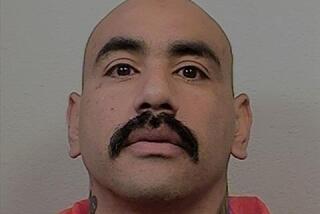Sleepy Lagoon Victims Laud Their Champion
Manny Reyes is 71 years old and the owner of a South Los Angeles taco stand. He also happens to be a seminal figure in Mexican American history, although not many people outside his circle of friends and family know this.
On Saturday, Reyes sat on a couch in a friend’s El Monte home, waiting to be reunited with the men who made history with him, more than 50 years ago, when they became targets of racial prejudice and symbols of injustice.
Reyes was a defendant in the infamous “Sleepy Lagoon” murder trial of 1942, an event dramatized in Luis Valdez’s play “Zoot Suit.” He was one of a dozen young men convicted in the case, which formed the backdrop for a frenzy of anti-Latino rioting in downtown Los Angeles.
Looking back, Reyes says he has adopted a “fatalistic” view of how he came to play a celebrated role in the emergence of Latino civil rights. “I’ve been blessed,” he said. God set the whole plan.”
Reyes and the other defendants gathered Saturday, as they have in years past, to celebrate the birthday of Alice Greenfield McGrath, 80, who helped organize the Sleepy Lagoon Defense Committee.
“This case wasn’t about justice,” McGrath said. “It was about punishing these kids for being Mexican and for dressing the way they did. It was racist. There’s no doubt about that.”
Then a twentysomething Jewish activist, McGrath spent the years 1942-44 writing and visiting the defendants in San Quentin, and making fervent speeches to raise money for their appeal.
“I place it as the most important event in my life,” McGrath said. “If I had never done anything since, . . . my involvement in Sleepy Lagoon would justify my existence.”
The early 1940s in Los Angeles were the era of the “pachuco,” Latino men who favored the long coats, the wide pants and the impossibly long watch chains of the zoot suit.
The case began when a 21-year-old Jose Diaz was found beaten to death at a Southside reservoir. The sensationalist press of the day, led by the Hearst-owned Los Angeles Examiner, dubbed the pond “the Sleepy Lagoon,” after a popular song of the day, and portrayed the defendants as dangerous gang members.
“It was the Hearst paper that started it,” McGrath recalled. “They did a series of articles on pachuco gangs. They made it sound as if they were raping and pillaging.”
McGrath sees in the Sleepy Lagoon trial and Zoot Suit riots a precursor to the immigrant-bashing of the 1990s, which some believe reached a crescendo with the approval of Proposition 187 by more than 60% of California voters.
“It is the same spirit, the same mean-spiritedness,” she said, echoing a passion for social justice that has not diminished with the passing of years. “Besides being wicked, it’s ignorant.”
With public outrage about the pachucos growing, sheriff’s officials went on a sweep through the city’s barrios, arresting more than 600 young men in the Sleepy Lagoon case. A grand jury eventually indicted 24 for murder, making the subsequent court proceeding one of the largest mass trials in American history.
The defendants were soon referred to in the press as “The Sleepy Lagooners” and then, more simply, as “goons.” In the courtroom, they were demonized as bloodthirsty hoodlums.
“Let us view it from the biological basis,” one Sheriff’s Department “expert” testified in the three-month trial. “Total disregard for human life has always been universal throughout the Americas in the human population. And this Mexican element feels a desire to kill or at least to draw blood.”
To then 17-year-old Hank Ynostroza, it was a farce. “I didn’t take it seriously, even though it really was serious,” he said.
In the courtroom, the defendants were placed in a “prisoners’ box” and not allowed to speak to their attorneys. Ynostroza remembers firing spit balls at his fellow defendants, prompting the judge to yell at them: “Hey, you zoot suiters got to be quiet!”
Later, in San Quentin, Ynostroza adopted a similarly relaxed attitude. He remembers playing pranks on the older inmates, using matches to “hot-foot” them in the exercise yard, behavior the warden and the guards tolerated because the “zoot suiters” were “just kids.”
“They knew we weren’t guilty,” Ynostroza said of the warden and the guards. “The warden told us, ‘I know you guys are going to go home, you’re going to beat that case. So just don’t get in any trouble while you’re here.’ ”
McGrath traveled to San Quentin every six weeks to discuss the appeal.
Ynostroza didn’t put much hope in her efforts. “We were young. I told her, ‘Go for it. If you can get us out, fine.’ ”
Reyes, meanwhile, can still recite his prison number: 69597. “I wasn’t ‘Mr. Reyes’ or ‘Punk,’ I was a number.”
He also remembered McGrath’s visits. As they embraced at Saturday’s reunion, he apologized for the one time when she came to see him in prison and he turned her away.
“You went to visit me in the attorney room in San Quentin, and I didn’t want to see you,” he told her, his voice tinged with regret.
“It doesn’t matter now,” she said.
Eventually, the efforts of McGrath and the Sleepy Lagoon defense attorneys proved fruitful.
An appeals court overturned all the convictions and severely reprimanded Judge Charles W. Fricke for displaying prejudice and hostility toward the defendants. After two years in jail and prison, the Sleepy Lagoon defendants were set free.
“Access to justice was the issue in the Sleepy Lagoon case,” McGrath said. Only two of the defendants had attorneys and in those days there was no public defender.
Having just turned 80, McGrath has not turned her back on the ideals that led her to help Reyes, Ynostroza and their friends 50 years ago. Today, she works in a Ventura County program providing volunteer attorneys to the poor.
More to Read
Sign up for Essential California
The most important California stories and recommendations in your inbox every morning.
You may occasionally receive promotional content from the Los Angeles Times.











